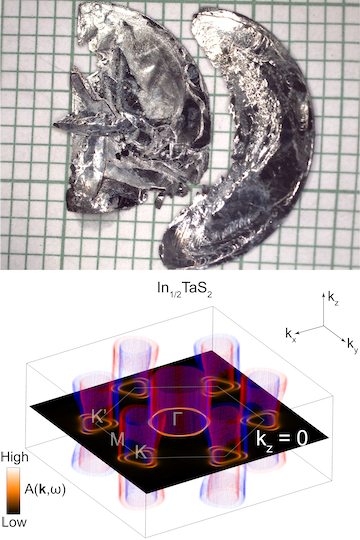New Super Material Featuring Indium and Tantalum Disulfide

Date

A sample of the newly developed In₁/₂TaS₂ (indium-doped tantalum disulfide), a quantum material engineered at Rice University. Bottom: Visualization of the Kramers nodal line behavior in momentum space, showing the protected electronic pathways that contribute to its superconductive and topological properties.Source: www.news.rice.edu
Rice University
How Indium-Doped Tantalum Disulfide Is Paving the Way for Quantum Devices
A recent discovery by researchers at Rice University, supported by the U.S. Air Force Office of Scientific Research and the Department of Defense, has the potential to reshape the future of electronics. By introducing a small amount of indium into Tantalum Disulfide (TaS₂), scientists have developed a novel quantum material with superconductive properties and distinct topological behavior.
This material, known as a Kramers nodal line metal, features an unusual electronic structure that could drive a new generation of ultra-efficient and powerful computing devices while minimizing energy loss. Published May 29th, 2025 in Nature Communications, the research represents a major step forward in the pursuit of low-energy-loss electronics and more sustainable technological solutions.
A Quantum Leap in Materials Science
The Rice-led team, directed by physicists Ming Yi and Emilia Morosan, found that precisely doping TaS₂ with indium disrupts its crystalline symmetry in a way that produces remarkable physical properties. Within this modified structure, electrons follow separate spin pathways. One for spin up and another for spin down, until they converge at a Kramers nodal line which is a symmetry-protected configuration that is rarely observed in solid-state physics.
In addition to this topological behavior, the material also exhibits superconductivity, meaning it can conduct electricity with zero resistance. This combination of traits paves the way for the creation of topological superconductors, which could be pivotal in advancing quantum computing, low-power electronics, and secure communications systems.
Advanced Measurement and Precise Control
Using tools such as spin-resolved angle-resolved photoemission spectroscopy and magnetic field transport measurements, researchers mapped how electrons behave within the material. These methods allowed the team to examine how varying levels of indium affect the energy, spin, and movement of charge carriers.
Yichen Zhang, a doctoral student and co-author of the study, explained that the team was able to fine-tune the material’s properties to emphasize its topological features. This approach offers a promising method for engineering future quantum materials with custom functionalities.
Implications for the Metals Industry
At D Block Metals, we view this research as more than just a scientific breakthrough. It underscores the growing relevance of specialty metals like tantalum and indium in next-generation technologies. As demand rises for materials that support quantum and superconductive performance, maintaining a secure and sustainable supply of these critical metals becomes increasingly important.
This advancement also reinforces the value of recycling and recovery programs focused on high-tech metals. A reliable domestic supply will be essential as the defense and electronics sectors place greater emphasis on advanced materials.
Moving Toward a Low-Loss Future
According to Yuxiang Gao, another co-author and doctoral student at Rice, the team has only begun to uncover the capabilities of this new class of material. As research continues, practical applications may soon emerge in fields such as microelectronics, power systems, and quantum information science. These advancements are being made possible through strategic alloying of indium, tantalum, and other rare elements.
Supported by the D.O.D. and the USAF, this work reflects the critical link between scientific research and industrial innovation. For material suppliers, manufacturers, and technology developers, preparing for the future of quantum materials is no longer optional, it’s a strategic necessity.


